Critical Review of Risk Assessment in Acute Mental Health Settings
VerifiedAdded on 2022/11/13
|6
|2444
|140
Essay
AI Summary
This essay provides a critical review of risk assessment in acute mental health settings, addressing the crucial role it plays for mental health professionals. It begins with an overview of the various types of risk assessments necessary, including those for suicide and violence, highlighting the importance of gathering comprehensive information from multiple sources. The essay then critiques the effectiveness and accuracy of current risk assessment methods, acknowledging limitations and the need for more rigorous research. It discusses the challenges in predicting mental health status and the influence of transient factors. Finally, the essay explores how the risk assessment process can be improved and optimized. It emphasizes the development of national guidelines, a community-wide mental health service approach, the use of standardized screening tools, and the importance of education and training for mental health practitioners and incorporating service user input. The essay stresses the need for further research to understand different perspectives on risk assessment and concludes by underscoring the importance of effective and timely risk assessment as a key element of risk management in acute mental health care.
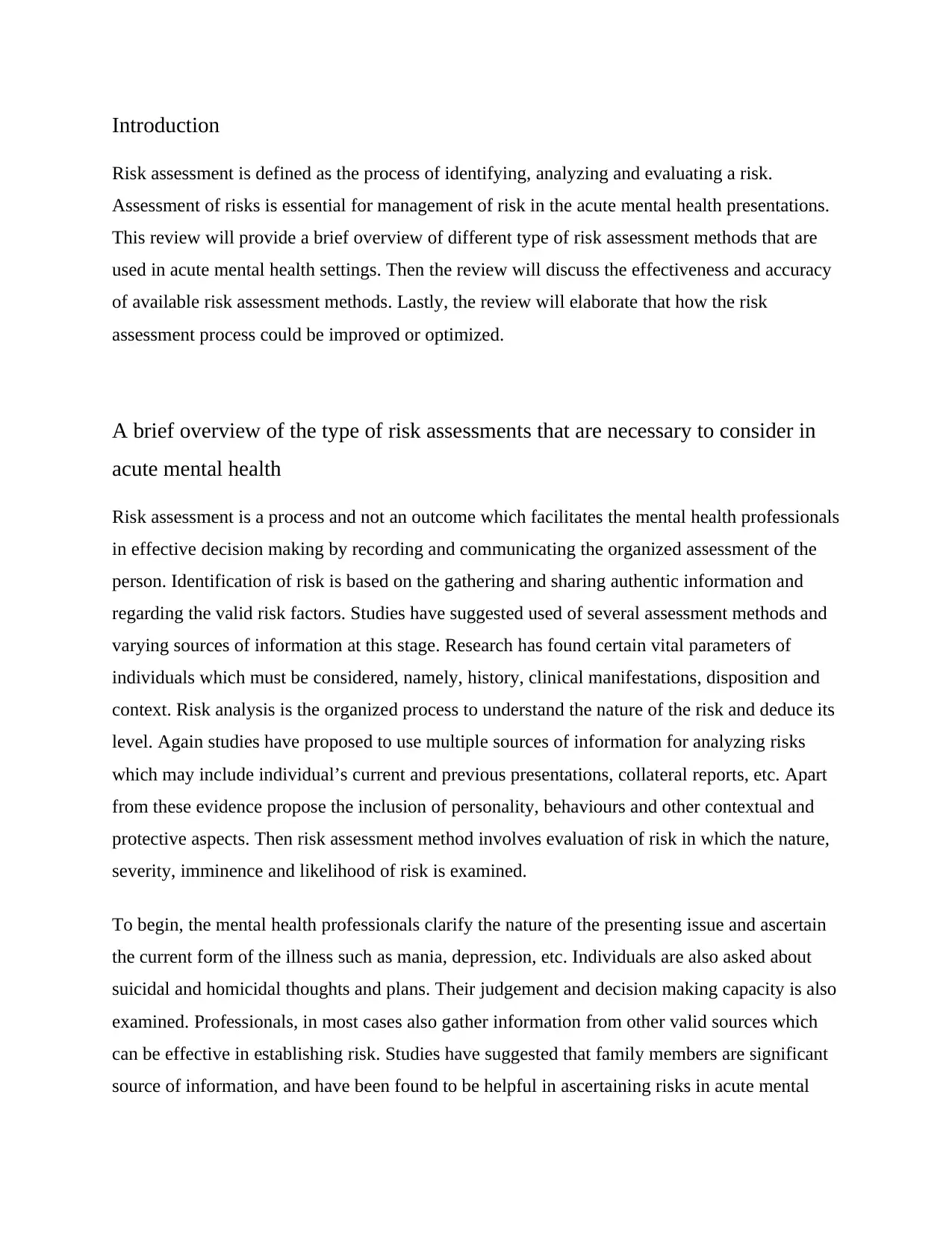
Introduction
Risk assessment is defined as the process of identifying, analyzing and evaluating a risk.
Assessment of risks is essential for management of risk in the acute mental health presentations.
This review will provide a brief overview of different type of risk assessment methods that are
used in acute mental health settings. Then the review will discuss the effectiveness and accuracy
of available risk assessment methods. Lastly, the review will elaborate that how the risk
assessment process could be improved or optimized.
A brief overview of the type of risk assessments that are necessary to consider in
acute mental health
Risk assessment is a process and not an outcome which facilitates the mental health professionals
in effective decision making by recording and communicating the organized assessment of the
person. Identification of risk is based on the gathering and sharing authentic information and
regarding the valid risk factors. Studies have suggested used of several assessment methods and
varying sources of information at this stage. Research has found certain vital parameters of
individuals which must be considered, namely, history, clinical manifestations, disposition and
context. Risk analysis is the organized process to understand the nature of the risk and deduce its
level. Again studies have proposed to use multiple sources of information for analyzing risks
which may include individual’s current and previous presentations, collateral reports, etc. Apart
from these evidence propose the inclusion of personality, behaviours and other contextual and
protective aspects. Then risk assessment method involves evaluation of risk in which the nature,
severity, imminence and likelihood of risk is examined.
To begin, the mental health professionals clarify the nature of the presenting issue and ascertain
the current form of the illness such as mania, depression, etc. Individuals are also asked about
suicidal and homicidal thoughts and plans. Their judgement and decision making capacity is also
examined. Professionals, in most cases also gather information from other valid sources which
can be effective in establishing risk. Studies have suggested that family members are significant
source of information, and have been found to be helpful in ascertaining risks in acute mental
Risk assessment is defined as the process of identifying, analyzing and evaluating a risk.
Assessment of risks is essential for management of risk in the acute mental health presentations.
This review will provide a brief overview of different type of risk assessment methods that are
used in acute mental health settings. Then the review will discuss the effectiveness and accuracy
of available risk assessment methods. Lastly, the review will elaborate that how the risk
assessment process could be improved or optimized.
A brief overview of the type of risk assessments that are necessary to consider in
acute mental health
Risk assessment is a process and not an outcome which facilitates the mental health professionals
in effective decision making by recording and communicating the organized assessment of the
person. Identification of risk is based on the gathering and sharing authentic information and
regarding the valid risk factors. Studies have suggested used of several assessment methods and
varying sources of information at this stage. Research has found certain vital parameters of
individuals which must be considered, namely, history, clinical manifestations, disposition and
context. Risk analysis is the organized process to understand the nature of the risk and deduce its
level. Again studies have proposed to use multiple sources of information for analyzing risks
which may include individual’s current and previous presentations, collateral reports, etc. Apart
from these evidence propose the inclusion of personality, behaviours and other contextual and
protective aspects. Then risk assessment method involves evaluation of risk in which the nature,
severity, imminence and likelihood of risk is examined.
To begin, the mental health professionals clarify the nature of the presenting issue and ascertain
the current form of the illness such as mania, depression, etc. Individuals are also asked about
suicidal and homicidal thoughts and plans. Their judgement and decision making capacity is also
examined. Professionals, in most cases also gather information from other valid sources which
can be effective in establishing risk. Studies have suggested that family members are significant
source of information, and have been found to be helpful in ascertaining risks in acute mental
Paraphrase This Document
Need a fresh take? Get an instant paraphrase of this document with our AI Paraphraser
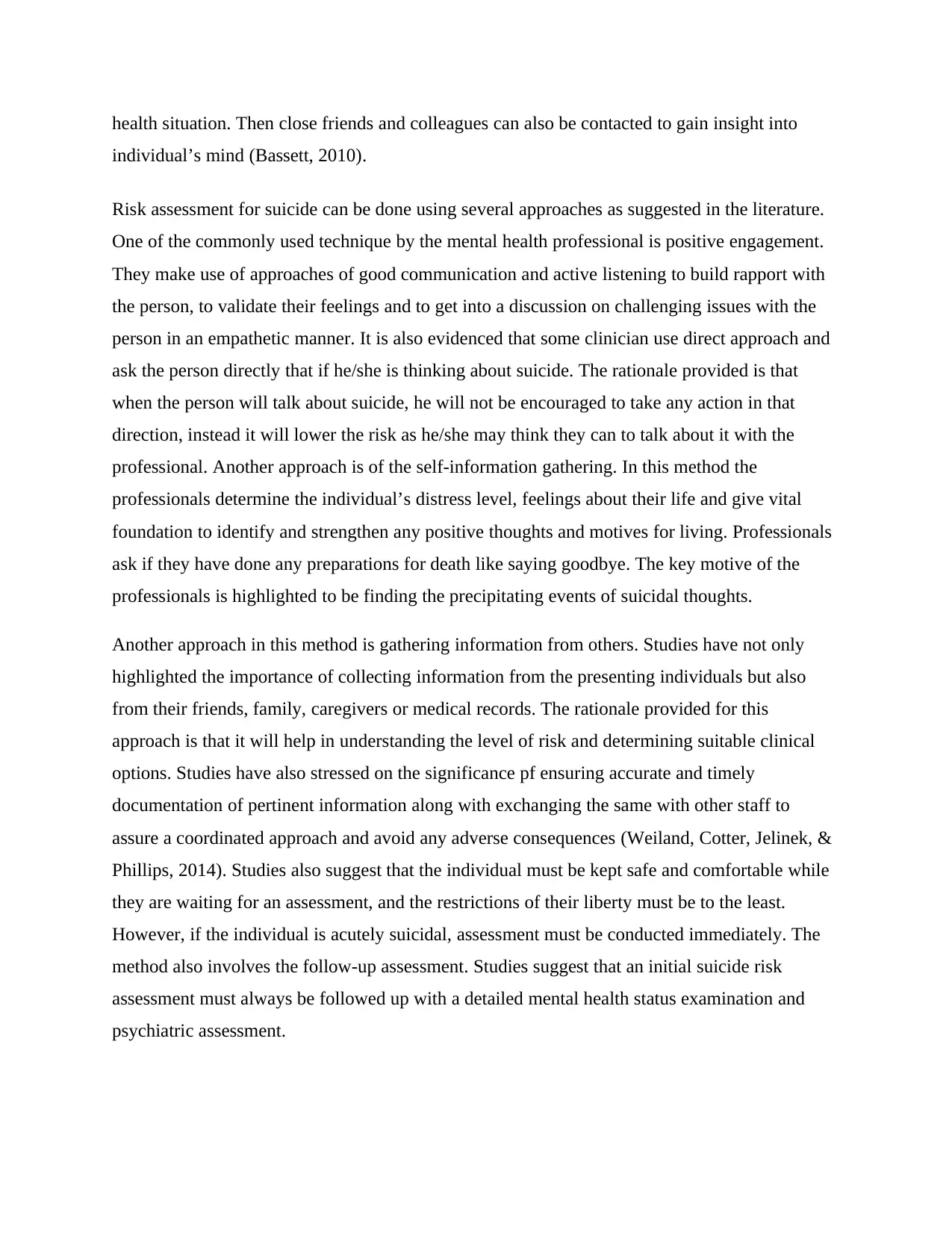
health situation. Then close friends and colleagues can also be contacted to gain insight into
individual’s mind (Bassett, 2010).
Risk assessment for suicide can be done using several approaches as suggested in the literature.
One of the commonly used technique by the mental health professional is positive engagement.
They make use of approaches of good communication and active listening to build rapport with
the person, to validate their feelings and to get into a discussion on challenging issues with the
person in an empathetic manner. It is also evidenced that some clinician use direct approach and
ask the person directly that if he/she is thinking about suicide. The rationale provided is that
when the person will talk about suicide, he will not be encouraged to take any action in that
direction, instead it will lower the risk as he/she may think they can to talk about it with the
professional. Another approach is of the self-information gathering. In this method the
professionals determine the individual’s distress level, feelings about their life and give vital
foundation to identify and strengthen any positive thoughts and motives for living. Professionals
ask if they have done any preparations for death like saying goodbye. The key motive of the
professionals is highlighted to be finding the precipitating events of suicidal thoughts.
Another approach in this method is gathering information from others. Studies have not only
highlighted the importance of collecting information from the presenting individuals but also
from their friends, family, caregivers or medical records. The rationale provided for this
approach is that it will help in understanding the level of risk and determining suitable clinical
options. Studies have also stressed on the significance pf ensuring accurate and timely
documentation of pertinent information along with exchanging the same with other staff to
assure a coordinated approach and avoid any adverse consequences (Weiland, Cotter, Jelinek, &
Phillips, 2014). Studies also suggest that the individual must be kept safe and comfortable while
they are waiting for an assessment, and the restrictions of their liberty must be to the least.
However, if the individual is acutely suicidal, assessment must be conducted immediately. The
method also involves the follow-up assessment. Studies suggest that an initial suicide risk
assessment must always be followed up with a detailed mental health status examination and
psychiatric assessment.
individual’s mind (Bassett, 2010).
Risk assessment for suicide can be done using several approaches as suggested in the literature.
One of the commonly used technique by the mental health professional is positive engagement.
They make use of approaches of good communication and active listening to build rapport with
the person, to validate their feelings and to get into a discussion on challenging issues with the
person in an empathetic manner. It is also evidenced that some clinician use direct approach and
ask the person directly that if he/she is thinking about suicide. The rationale provided is that
when the person will talk about suicide, he will not be encouraged to take any action in that
direction, instead it will lower the risk as he/she may think they can to talk about it with the
professional. Another approach is of the self-information gathering. In this method the
professionals determine the individual’s distress level, feelings about their life and give vital
foundation to identify and strengthen any positive thoughts and motives for living. Professionals
ask if they have done any preparations for death like saying goodbye. The key motive of the
professionals is highlighted to be finding the precipitating events of suicidal thoughts.
Another approach in this method is gathering information from others. Studies have not only
highlighted the importance of collecting information from the presenting individuals but also
from their friends, family, caregivers or medical records. The rationale provided for this
approach is that it will help in understanding the level of risk and determining suitable clinical
options. Studies have also stressed on the significance pf ensuring accurate and timely
documentation of pertinent information along with exchanging the same with other staff to
assure a coordinated approach and avoid any adverse consequences (Weiland, Cotter, Jelinek, &
Phillips, 2014). Studies also suggest that the individual must be kept safe and comfortable while
they are waiting for an assessment, and the restrictions of their liberty must be to the least.
However, if the individual is acutely suicidal, assessment must be conducted immediately. The
method also involves the follow-up assessment. Studies suggest that an initial suicide risk
assessment must always be followed up with a detailed mental health status examination and
psychiatric assessment.
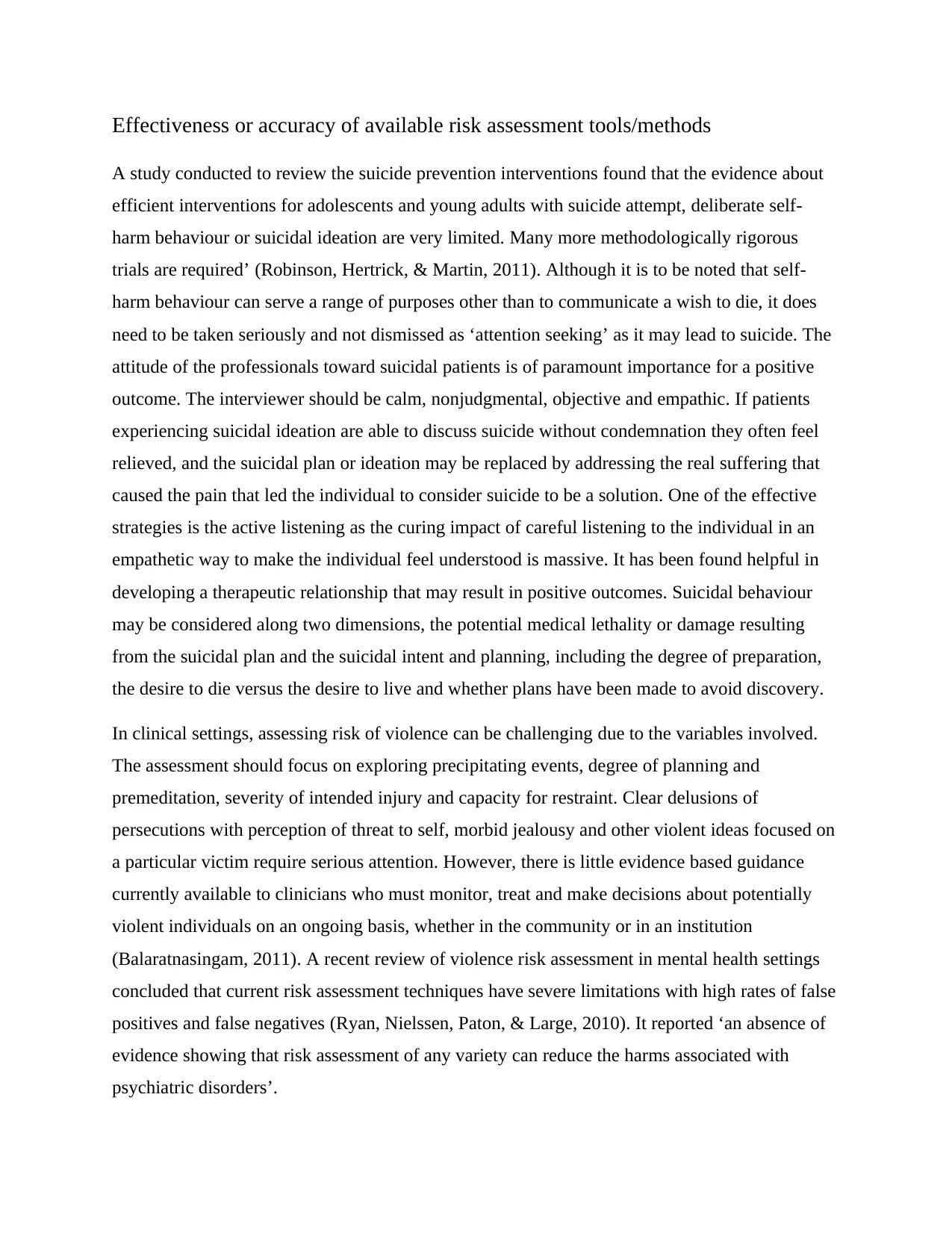
Effectiveness or accuracy of available risk assessment tools/methods
A study conducted to review the suicide prevention interventions found that the evidence about
efficient interventions for adolescents and young adults with suicide attempt, deliberate self-
harm behaviour or suicidal ideation are very limited. Many more methodologically rigorous
trials are required’ (Robinson, Hertrick, & Martin, 2011). Although it is to be noted that self-
harm behaviour can serve a range of purposes other than to communicate a wish to die, it does
need to be taken seriously and not dismissed as ‘attention seeking’ as it may lead to suicide. The
attitude of the professionals toward suicidal patients is of paramount importance for a positive
outcome. The interviewer should be calm, nonjudgmental, objective and empathic. If patients
experiencing suicidal ideation are able to discuss suicide without condemnation they often feel
relieved, and the suicidal plan or ideation may be replaced by addressing the real suffering that
caused the pain that led the individual to consider suicide to be a solution. One of the effective
strategies is the active listening as the curing impact of careful listening to the individual in an
empathetic way to make the individual feel understood is massive. It has been found helpful in
developing a therapeutic relationship that may result in positive outcomes. Suicidal behaviour
may be considered along two dimensions, the potential medical lethality or damage resulting
from the suicidal plan and the suicidal intent and planning, including the degree of preparation,
the desire to die versus the desire to live and whether plans have been made to avoid discovery.
In clinical settings, assessing risk of violence can be challenging due to the variables involved.
The assessment should focus on exploring precipitating events, degree of planning and
premeditation, severity of intended injury and capacity for restraint. Clear delusions of
persecutions with perception of threat to self, morbid jealousy and other violent ideas focused on
a particular victim require serious attention. However, there is little evidence based guidance
currently available to clinicians who must monitor, treat and make decisions about potentially
violent individuals on an ongoing basis, whether in the community or in an institution
(Balaratnasingam, 2011). A recent review of violence risk assessment in mental health settings
concluded that current risk assessment techniques have severe limitations with high rates of false
positives and false negatives (Ryan, Nielssen, Paton, & Large, 2010). It reported ‘an absence of
evidence showing that risk assessment of any variety can reduce the harms associated with
psychiatric disorders’.
A study conducted to review the suicide prevention interventions found that the evidence about
efficient interventions for adolescents and young adults with suicide attempt, deliberate self-
harm behaviour or suicidal ideation are very limited. Many more methodologically rigorous
trials are required’ (Robinson, Hertrick, & Martin, 2011). Although it is to be noted that self-
harm behaviour can serve a range of purposes other than to communicate a wish to die, it does
need to be taken seriously and not dismissed as ‘attention seeking’ as it may lead to suicide. The
attitude of the professionals toward suicidal patients is of paramount importance for a positive
outcome. The interviewer should be calm, nonjudgmental, objective and empathic. If patients
experiencing suicidal ideation are able to discuss suicide without condemnation they often feel
relieved, and the suicidal plan or ideation may be replaced by addressing the real suffering that
caused the pain that led the individual to consider suicide to be a solution. One of the effective
strategies is the active listening as the curing impact of careful listening to the individual in an
empathetic way to make the individual feel understood is massive. It has been found helpful in
developing a therapeutic relationship that may result in positive outcomes. Suicidal behaviour
may be considered along two dimensions, the potential medical lethality or damage resulting
from the suicidal plan and the suicidal intent and planning, including the degree of preparation,
the desire to die versus the desire to live and whether plans have been made to avoid discovery.
In clinical settings, assessing risk of violence can be challenging due to the variables involved.
The assessment should focus on exploring precipitating events, degree of planning and
premeditation, severity of intended injury and capacity for restraint. Clear delusions of
persecutions with perception of threat to self, morbid jealousy and other violent ideas focused on
a particular victim require serious attention. However, there is little evidence based guidance
currently available to clinicians who must monitor, treat and make decisions about potentially
violent individuals on an ongoing basis, whether in the community or in an institution
(Balaratnasingam, 2011). A recent review of violence risk assessment in mental health settings
concluded that current risk assessment techniques have severe limitations with high rates of false
positives and false negatives (Ryan, Nielssen, Paton, & Large, 2010). It reported ‘an absence of
evidence showing that risk assessment of any variety can reduce the harms associated with
psychiatric disorders’.
⊘ This is a preview!⊘
Do you want full access?
Subscribe today to unlock all pages.

Trusted by 1+ million students worldwide
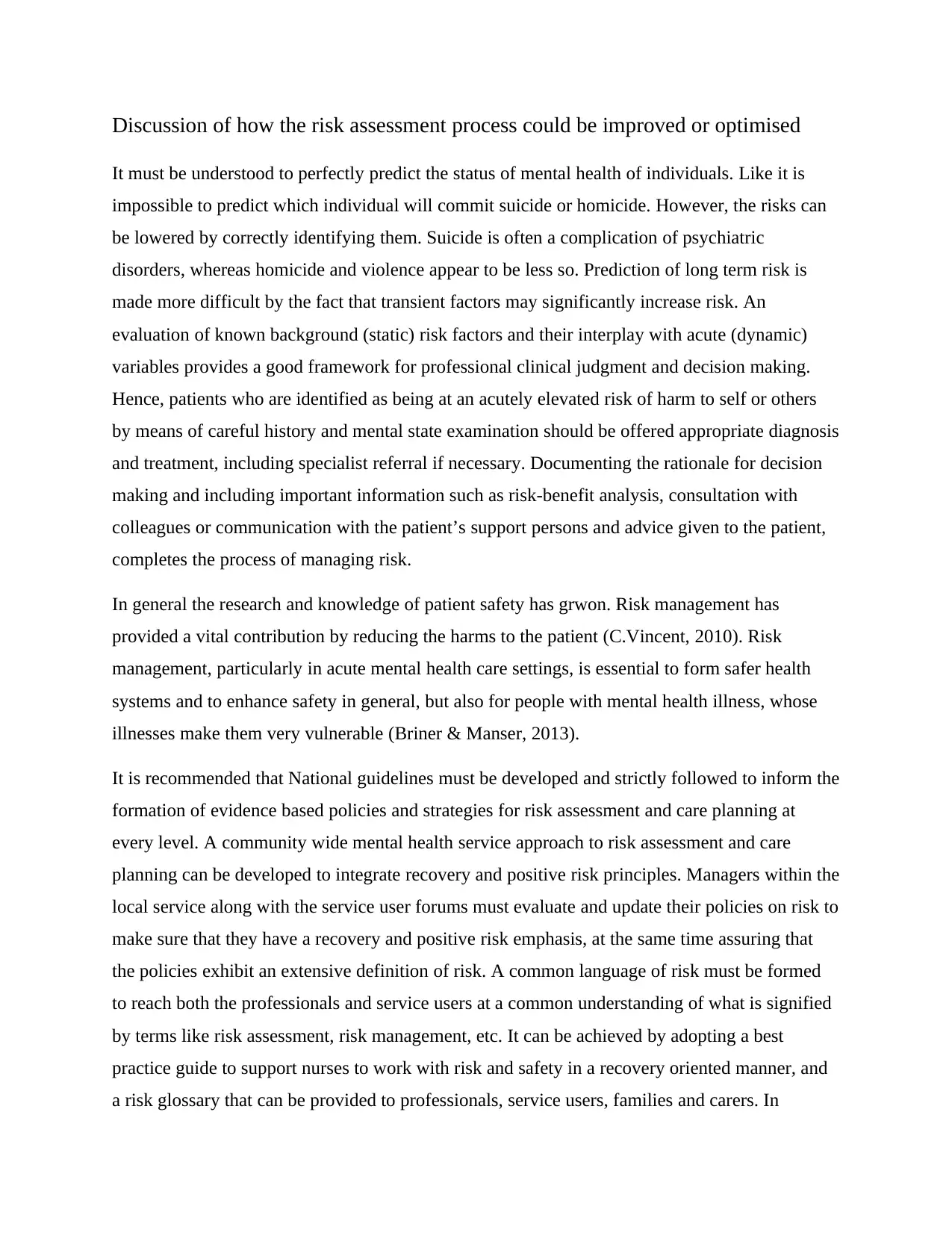
Discussion of how the risk assessment process could be improved or optimised
It must be understood to perfectly predict the status of mental health of individuals. Like it is
impossible to predict which individual will commit suicide or homicide. However, the risks can
be lowered by correctly identifying them. Suicide is often a complication of psychiatric
disorders, whereas homicide and violence appear to be less so. Prediction of long term risk is
made more difficult by the fact that transient factors may significantly increase risk. An
evaluation of known background (static) risk factors and their interplay with acute (dynamic)
variables provides a good framework for professional clinical judgment and decision making.
Hence, patients who are identified as being at an acutely elevated risk of harm to self or others
by means of careful history and mental state examination should be offered appropriate diagnosis
and treatment, including specialist referral if necessary. Documenting the rationale for decision
making and including important information such as risk-benefit analysis, consultation with
colleagues or communication with the patient’s support persons and advice given to the patient,
completes the process of managing risk.
In general the research and knowledge of patient safety has grwon. Risk management has
provided a vital contribution by reducing the harms to the patient (C.Vincent, 2010). Risk
management, particularly in acute mental health care settings, is essential to form safer health
systems and to enhance safety in general, but also for people with mental health illness, whose
illnesses make them very vulnerable (Briner & Manser, 2013).
It is recommended that National guidelines must be developed and strictly followed to inform the
formation of evidence based policies and strategies for risk assessment and care planning at
every level. A community wide mental health service approach to risk assessment and care
planning can be developed to integrate recovery and positive risk principles. Managers within the
local service along with the service user forums must evaluate and update their policies on risk to
make sure that they have a recovery and positive risk emphasis, at the same time assuring that
the policies exhibit an extensive definition of risk. A common language of risk must be formed
to reach both the professionals and service users at a common understanding of what is signified
by terms like risk assessment, risk management, etc. It can be achieved by adopting a best
practice guide to support nurses to work with risk and safety in a recovery oriented manner, and
a risk glossary that can be provided to professionals, service users, families and carers. In
It must be understood to perfectly predict the status of mental health of individuals. Like it is
impossible to predict which individual will commit suicide or homicide. However, the risks can
be lowered by correctly identifying them. Suicide is often a complication of psychiatric
disorders, whereas homicide and violence appear to be less so. Prediction of long term risk is
made more difficult by the fact that transient factors may significantly increase risk. An
evaluation of known background (static) risk factors and their interplay with acute (dynamic)
variables provides a good framework for professional clinical judgment and decision making.
Hence, patients who are identified as being at an acutely elevated risk of harm to self or others
by means of careful history and mental state examination should be offered appropriate diagnosis
and treatment, including specialist referral if necessary. Documenting the rationale for decision
making and including important information such as risk-benefit analysis, consultation with
colleagues or communication with the patient’s support persons and advice given to the patient,
completes the process of managing risk.
In general the research and knowledge of patient safety has grwon. Risk management has
provided a vital contribution by reducing the harms to the patient (C.Vincent, 2010). Risk
management, particularly in acute mental health care settings, is essential to form safer health
systems and to enhance safety in general, but also for people with mental health illness, whose
illnesses make them very vulnerable (Briner & Manser, 2013).
It is recommended that National guidelines must be developed and strictly followed to inform the
formation of evidence based policies and strategies for risk assessment and care planning at
every level. A community wide mental health service approach to risk assessment and care
planning can be developed to integrate recovery and positive risk principles. Managers within the
local service along with the service user forums must evaluate and update their policies on risk to
make sure that they have a recovery and positive risk emphasis, at the same time assuring that
the policies exhibit an extensive definition of risk. A common language of risk must be formed
to reach both the professionals and service users at a common understanding of what is signified
by terms like risk assessment, risk management, etc. It can be achieved by adopting a best
practice guide to support nurses to work with risk and safety in a recovery oriented manner, and
a risk glossary that can be provided to professionals, service users, families and carers. In
Paraphrase This Document
Need a fresh take? Get an instant paraphrase of this document with our AI Paraphraser
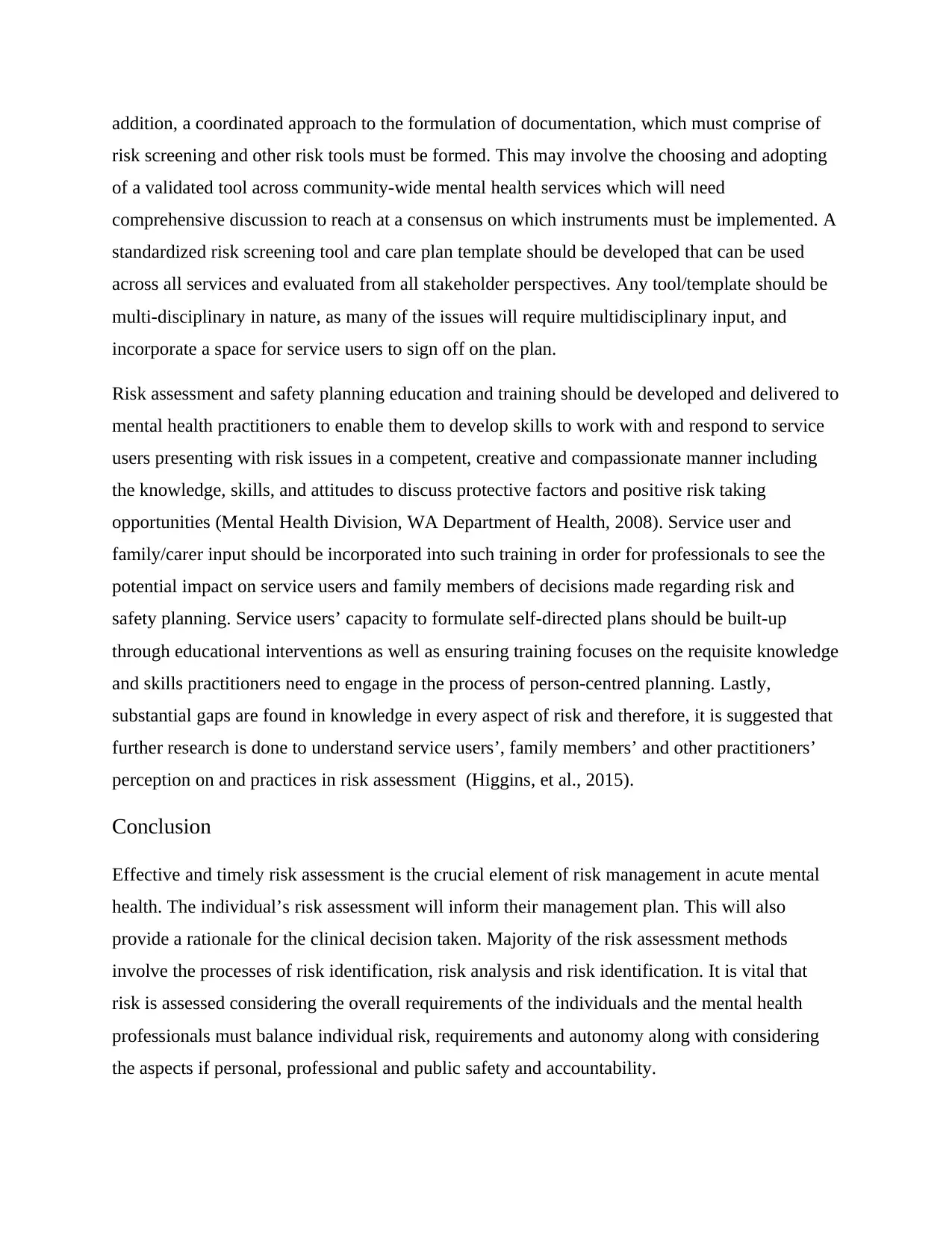
addition, a coordinated approach to the formulation of documentation, which must comprise of
risk screening and other risk tools must be formed. This may involve the choosing and adopting
of a validated tool across community-wide mental health services which will need
comprehensive discussion to reach at a consensus on which instruments must be implemented. A
standardized risk screening tool and care plan template should be developed that can be used
across all services and evaluated from all stakeholder perspectives. Any tool/template should be
multi-disciplinary in nature, as many of the issues will require multidisciplinary input, and
incorporate a space for service users to sign off on the plan.
Risk assessment and safety planning education and training should be developed and delivered to
mental health practitioners to enable them to develop skills to work with and respond to service
users presenting with risk issues in a competent, creative and compassionate manner including
the knowledge, skills, and attitudes to discuss protective factors and positive risk taking
opportunities (Mental Health Division, WA Department of Health, 2008). Service user and
family/carer input should be incorporated into such training in order for professionals to see the
potential impact on service users and family members of decisions made regarding risk and
safety planning. Service users’ capacity to formulate self-directed plans should be built-up
through educational interventions as well as ensuring training focuses on the requisite knowledge
and skills practitioners need to engage in the process of person-centred planning. Lastly,
substantial gaps are found in knowledge in every aspect of risk and therefore, it is suggested that
further research is done to understand service users’, family members’ and other practitioners’
perception on and practices in risk assessment (Higgins, et al., 2015).
Conclusion
Effective and timely risk assessment is the crucial element of risk management in acute mental
health. The individual’s risk assessment will inform their management plan. This will also
provide a rationale for the clinical decision taken. Majority of the risk assessment methods
involve the processes of risk identification, risk analysis and risk identification. It is vital that
risk is assessed considering the overall requirements of the individuals and the mental health
professionals must balance individual risk, requirements and autonomy along with considering
the aspects if personal, professional and public safety and accountability.
risk screening and other risk tools must be formed. This may involve the choosing and adopting
of a validated tool across community-wide mental health services which will need
comprehensive discussion to reach at a consensus on which instruments must be implemented. A
standardized risk screening tool and care plan template should be developed that can be used
across all services and evaluated from all stakeholder perspectives. Any tool/template should be
multi-disciplinary in nature, as many of the issues will require multidisciplinary input, and
incorporate a space for service users to sign off on the plan.
Risk assessment and safety planning education and training should be developed and delivered to
mental health practitioners to enable them to develop skills to work with and respond to service
users presenting with risk issues in a competent, creative and compassionate manner including
the knowledge, skills, and attitudes to discuss protective factors and positive risk taking
opportunities (Mental Health Division, WA Department of Health, 2008). Service user and
family/carer input should be incorporated into such training in order for professionals to see the
potential impact on service users and family members of decisions made regarding risk and
safety planning. Service users’ capacity to formulate self-directed plans should be built-up
through educational interventions as well as ensuring training focuses on the requisite knowledge
and skills practitioners need to engage in the process of person-centred planning. Lastly,
substantial gaps are found in knowledge in every aspect of risk and therefore, it is suggested that
further research is done to understand service users’, family members’ and other practitioners’
perception on and practices in risk assessment (Higgins, et al., 2015).
Conclusion
Effective and timely risk assessment is the crucial element of risk management in acute mental
health. The individual’s risk assessment will inform their management plan. This will also
provide a rationale for the clinical decision taken. Majority of the risk assessment methods
involve the processes of risk identification, risk analysis and risk identification. It is vital that
risk is assessed considering the overall requirements of the individuals and the mental health
professionals must balance individual risk, requirements and autonomy along with considering
the aspects if personal, professional and public safety and accountability.
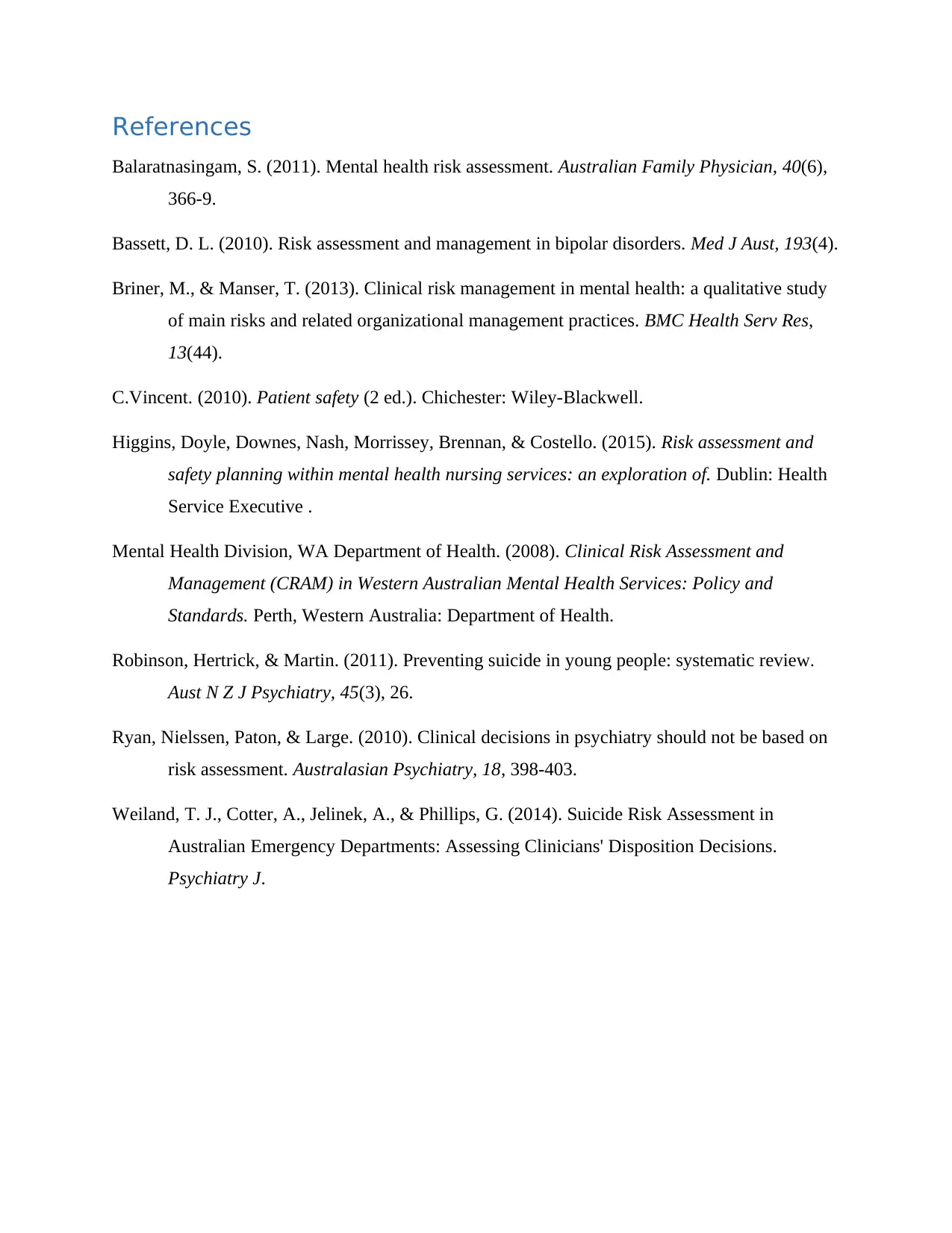
References
Balaratnasingam, S. (2011). Mental health risk assessment. Australian Family Physician, 40(6),
366-9.
Bassett, D. L. (2010). Risk assessment and management in bipolar disorders. Med J Aust, 193(4).
Briner, M., & Manser, T. (2013). Clinical risk management in mental health: a qualitative study
of main risks and related organizational management practices. BMC Health Serv Res,
13(44).
C.Vincent. (2010). Patient safety (2 ed.). Chichester: Wiley-Blackwell.
Higgins, Doyle, Downes, Nash, Morrissey, Brennan, & Costello. (2015). Risk assessment and
safety planning within mental health nursing services: an exploration of. Dublin: Health
Service Executive .
Mental Health Division, WA Department of Health. (2008). Clinical Risk Assessment and
Management (CRAM) in Western Australian Mental Health Services: Policy and
Standards. Perth, Western Australia: Department of Health.
Robinson, Hertrick, & Martin. (2011). Preventing suicide in young people: systematic review.
Aust N Z J Psychiatry, 45(3), 26.
Ryan, Nielssen, Paton, & Large. (2010). Clinical decisions in psychiatry should not be based on
risk assessment. Australasian Psychiatry, 18, 398-403.
Weiland, T. J., Cotter, A., Jelinek, A., & Phillips, G. (2014). Suicide Risk Assessment in
Australian Emergency Departments: Assessing Clinicians' Disposition Decisions.
Psychiatry J.
Balaratnasingam, S. (2011). Mental health risk assessment. Australian Family Physician, 40(6),
366-9.
Bassett, D. L. (2010). Risk assessment and management in bipolar disorders. Med J Aust, 193(4).
Briner, M., & Manser, T. (2013). Clinical risk management in mental health: a qualitative study
of main risks and related organizational management practices. BMC Health Serv Res,
13(44).
C.Vincent. (2010). Patient safety (2 ed.). Chichester: Wiley-Blackwell.
Higgins, Doyle, Downes, Nash, Morrissey, Brennan, & Costello. (2015). Risk assessment and
safety planning within mental health nursing services: an exploration of. Dublin: Health
Service Executive .
Mental Health Division, WA Department of Health. (2008). Clinical Risk Assessment and
Management (CRAM) in Western Australian Mental Health Services: Policy and
Standards. Perth, Western Australia: Department of Health.
Robinson, Hertrick, & Martin. (2011). Preventing suicide in young people: systematic review.
Aust N Z J Psychiatry, 45(3), 26.
Ryan, Nielssen, Paton, & Large. (2010). Clinical decisions in psychiatry should not be based on
risk assessment. Australasian Psychiatry, 18, 398-403.
Weiland, T. J., Cotter, A., Jelinek, A., & Phillips, G. (2014). Suicide Risk Assessment in
Australian Emergency Departments: Assessing Clinicians' Disposition Decisions.
Psychiatry J.
⊘ This is a preview!⊘
Do you want full access?
Subscribe today to unlock all pages.

Trusted by 1+ million students worldwide
1 out of 6
Related Documents
Your All-in-One AI-Powered Toolkit for Academic Success.
+13062052269
info@desklib.com
Available 24*7 on WhatsApp / Email
![[object Object]](/_next/static/media/star-bottom.7253800d.svg)
Unlock your academic potential
Copyright © 2020–2025 A2Z Services. All Rights Reserved. Developed and managed by ZUCOL.




